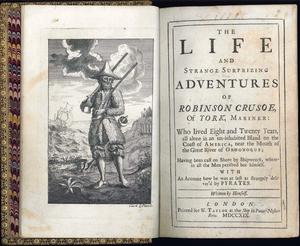| Notes |

The first edition of one of the most famous works of English literature, "the greatest mythic fantasy ever written of the solitary survivor who will never succumb" (Oxford Dictionary of National Biography). One of six copies recorded as being held in major UK libraries by ESTC. Defoe’s novel draws on contemporary travel narratives and tales of real-life castaways, such as Scottish sailor/buccaneer, Alexander Selkirk. Slavery and British colonialism are key backdrops to the novel, informing nearly every aspect of the plot, characters and ideas contained within it.
Set in the 17th century and narrated retrospectively in the first-person, Crusoe is a young Englishman of German ancestry (birth name Robinson Kreutznaer). He is drawn to the sea regardless of parental and what appear to be providential warnings of catastrophe. After many adventures and disasters, he finds unbounded economic opportunity in Brazil. He then joins an expedition to purchase slaves from Africa but is shipwrecked in a storm about forty miles out to sea on an island off the Venezuelan coast (the 'Island of Despair').
Over 20 years go by before Crusoe spots a human footprint, not his own, on the sand; it turns out to belong to a visiting cannibal, a group of whom sometimes come to the island to kill and eat prisoners they have captured at sea. Several more years pass before one of those prisoners escapes and becomes Crusoe’s attendant. Naming him 'Man Friday', after the day of the week he finds him, Crusoe converts Friday to Christianity and teaches him the English language. Ultimately, after 27 years on the island, Crusoe negotiates passage on an English ship which stops by. He returns home, only to find he has been believed long since dead by his family and disinherited. He continues his life and travels (by land) as a colonial trader, and the book ends with the promise of narrating more of his escapades in the future.
An initial edition of 1,000 was printed near the end of April 1719, followed by a second edition on 9 May, a third about 6 June, and a fourth shortly before the publication of the sequel, Farther Adventures of Robinson Crusoe, in August 1719. Within a year the book had been translated into French, German, and Dutch. From the Honresfield Blavatnik Library purchased by the Friends of the National Libraries.
|

